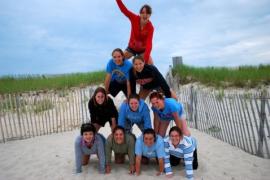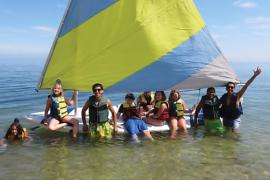Cathy’s story: “He looks like me but he sure don’t talk like me” was the comment I heard from an 11-year-old camper as he described his counselor who was black but from South Africa. In my early and admittedly failed attempts to mirror my staff to reflect my camper population, I did not understand what was most important to my campers and their parents — their identity — whether they were African American, Hmong, or Latino. Caucasian kids were for the most part easy to recruit, but I struggled for the five years I directed Camp Indian Sands with recruiting campers of color. As a young camp professional and first-time camp director, I felt we had a great program that offered youth the opportunity to leave the city for a week and experience the great outdoors, but I never understood the resistance from parents sending their children to camp. I just didn’t get it. I didn’t know how to engage people in communities different than the one where I had grown up.
Maysee’s story: I’m a Hmong American woman who was born in a refugee camp in Ban Vinai, Thailand. My family’s home was destroyed as a result of war. My family came to the United States from the Ban Vinai refugee camp in 1976, when I was only a few months old. While in grade school, I went to an almost all Caucasian elementary school. Sleepovers for birthdays and summer events were very popular among my Caucasian friends. But sleepovers were a foreign concept to my Hmong parents, who could not conceive of the purpose of having one. It was always a huge ordeal when a friend’s parent had to call my parents to explain what would be happening during the sleepover and who would be present. When I was allowed to attend a sleepover, I always had to come home immediately the next morning. Because of our history, residential camp did not have a good meaning to my family. My closest experience to camp during grade school was an overnight campout with my class on school forest land, which my parents more readily allowed because it was a school activity.
These are our histories; they have had a profound impact on our perspectives about camp — just as the histories and experiences of individuals from a wide range of cultures and backgrounds color their perceptions of our industry.
A Historical Perspective
The experience we know as camp today has a long history dating back over 150 years. Organized camp was founded at the dawn of the Civil War in 1861 (Eells, 1986), a time when the country was divided, slavery was still an accepted practice in parts of the United States, and Native Americans and immigrants were expected to assimilate to a predominantly Euro-centric culture. While some camps were originally founded as a constructive summer experience for the children of predominantly white, affluent families, other camps, such as those established through the YMCA, YWCA, and the Fresh Air Fund Movement, recognized the need to get kids out of city ghettos and slums and prevent children from being thrown into child labor, particularly in urban factories (Hanson & Carlson, 1972). Early camp professionals saw the need and worked to provide a camp experience for a variety of identified audiences, as do camp professionals today. As Bob Ditter (2013) put it, “We see ourselves as good people with the best of intentions trying to help all children develop character and the qualities that will make them better citizens and more successful in life.” Human rights activist Peggy McIntosh suggested that when we work to benefit others, what we don’t often see is that we are working to make them “more like us” (1989). Often, camp professionals did not, and do not, consider the lived histories of diversified audiences. As an industry, we will continue to struggle to reach different audiences and truly diversify our programs if we do not begin to understand cultural differences and how these impact a parent’s willingness to send their child to camp as well as the child’s camp experience.
Understanding Barriers and Enhancing Your Camp’s Outreach
The many barriers to the camp experience for children of diverse cultural and ethnic backgrounds can create resistance in participation by children of color and their parents. The context by which we as camp professionals define what camp means, and the understanding of what it means to prospective campers and parents is widely varied and, depending on the audience, sometimes negative. Depending on one’s background experience, the term “camp” can trigger different perceptions and feelings. Other families may question the purpose of camp and why it is valuable. What kind of learning could possibly take place with others in the woods? There are fears of the unknown and of trusting strangers to take care of their children that is acceptable to me. For some, the cost alone may be a barrier or seem extravagant. Some families may want to know if anyone else in the camp will look like their child and understand their child’s needs, language, and cultural restrictions.
Too often in schools and camps, there are accepted practices and expectations that may be in conflict with others’ cultural norms. For example, children are frequently told they can only speak English, but research does not necessarily support the notion that this practice will build confidence in campers for whom English is a second language. Camp games that require physical contact with members of the opposite sex may be considered taboo in some cultures. Likewise, the typical camp uniform of shorts and bathing suits may be of concern to individuals whose culture and/or religion dictates other forms of dress. These are all subjects that demand careful consideration when camps are reaching out to diverse populations.
Most important, families want to know there are people at camp they can trust to care for their children. When camp is not part of a family’s culture or history, trust is built with time, commitment, and respect. We must make the effort to understand the possible concerns and discomforts of those different from ourselves. This may take years.
Don’t expect families to assimilate automatically to the culture of camp. Perhaps it is camp that must change. If we want to expand our reach, we have to begin to understand other cultures and build relationships across cultures. The relationships between camp staff and their camp families must be reciprocal. We must believe what we say and do what we say.
When there is a disconnect between what we as camp professionals know to be a positive experience (Thurber, Scanlin, Scheuler, & Henderson, 2007) and what families of color or other marginalized populations perceive, understand, or experience camps to be, we limit the opportunity for more campers to participate. Our goal as camp professionals should be to reach across boundaries and out to different audiences, working to establish the trust and relationships that will allow us to provide experiences that match cultural expectations.
How to Build RelationshipsMeeting diverse audiences where they are is critical to building trusting relationships with the families we want to recruit. The everyday life experiences of many people of color and diverse backgrounds have taught them to be leery of entering spaces and asking questions in areas where the dominant social norms may not be their own. Take time to go to them. When you meet diverse audiences where they are, you have taken an important first step. Consider utilizing a public venue such as a community festival for meeting people of different racial and cultural backgrounds. Many of these festivals will allow organizations to provide information booths where pamphlets and other resources can be provided. Some of these materials may need to be available in different languages. Stepping a little outside of our own comfort zones can pay off greatly in terms of recruitment. At these festivals or elsewhere, try to speak a few words in the language that is being spoken if it’s other than English, wear accessories that demonstrate interest in the cultures being celebrated, or eat different foods on display. All of these efforts can go a long way. You might also consider bringing someone from the community with you to help bridge any cultural divide. Build Trust with Prospective Camper FamiliesCamp recruiters, employees, and administrators who are willing and able to engage in difficult conversations about race and culture can also gain great strides in building relationships with those families we’re trying to bring to our camps. What do you do if a family of color allows their child to attend camp and the child is called several racial slurs by some other campers? The family will want to know that the camp identifies these incidents as serious ones and that the offending campers will face appropriate consequences. It is essential that you can explain to the family that providing detailed training to all staff well before campers arrive in how to deal with this serious issue is a paramount part of your camp’s policy. Provide Experiences that Match Cultural ExpectationsDevelop programs that address barriers and involve stakeholders. The challenge is to incorporate these programs into your camp curriculum rather than make them separate and apart from regular camp activities. The goal is to create an environment, program, and experience that matches the cultural expectations of parents and campers. You want to build your program in ways that address cultural differences of all audiences.
|
Photo courtesy of Girl Scouts of the Chesapeake Bay, Newark, Delaware
References
Ditter, B. (2013, January). A deeper understanding – Implications of race for the future of camp. Camping Magazine. Retrieved from ACAcamps.org/resource-library/camping-magazine/deeper-understanding-implications-race-future-camp
Eells, E. (1986). History of organized camping: The first 100 Years. Martinsville, IN: American Camping Association.
Hanson, R. F., & Carlson, R. E. (1972). Organizations for children and youth. Englewood, NJ: Prentice Hall, Inc.
McIntosh, P. (1989, July). White privilege: Unpacking the invisible knapsack. Peace and Freedom Magazine. Retrieved from https://nationalseedproject.org/white-privilege-unpacking-the-invisible-knapsack
Thurber, C. A., Scanlin, M. M., Scheuler, L., & Henderson, K. A. (2007). Youth development outcomes of the camp experience: Evidence for multidimensional growth. Journal of Youth and Adolescence, 36(3), 241–254.
Maysee Yang Herr, PhD, is an associate professor of education at the University of Wisconsin-Stevens Point. Her research interest focuses on how young children understand and discuss social issues. She is the founder and director of Camp Phoojywg-Friend, a program addressing Hmong culture and language for all audiences.
Cathy Scheder, EdD, is a program specialist in the School of Education Graduate Office at the University of Wisconsin-Stevens Point, where she also chairs the Diversity Council for the university. She has been involved with camp since 1989 as a counselor, waterfront director, and camp director, and facilitates professional development for camp and youth programs. Cathy is actively involved with ACA as an Accreditation visitor, instructor, and trainer of instructors, and is the chair for the ACA, WI LCOL. She is the author of Camp Waterfront Management.


